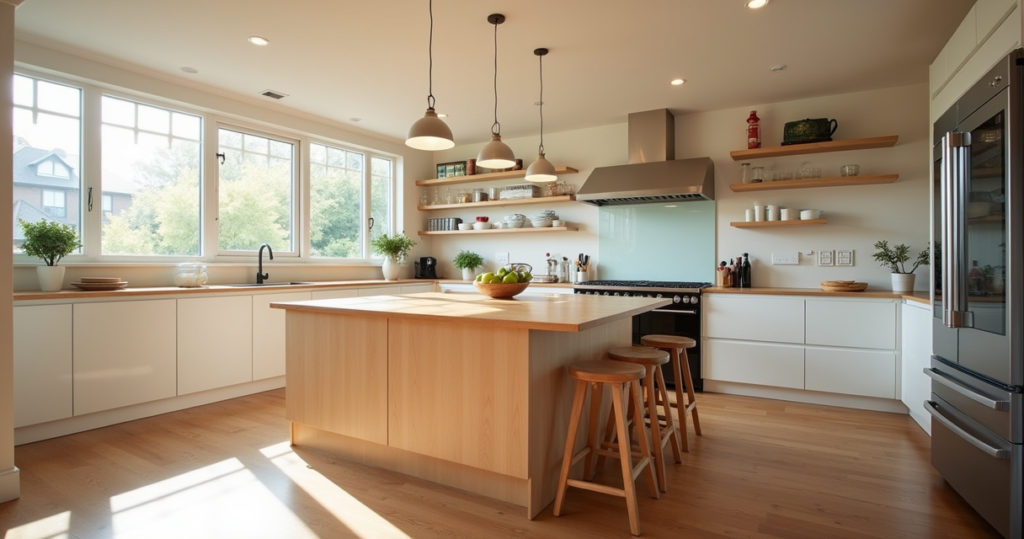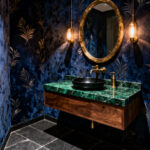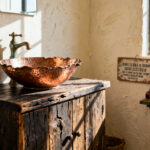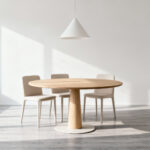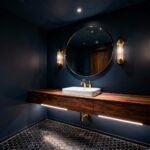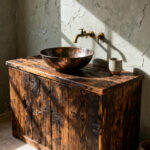The kitchen has evolved far beyond its utilitarian roots to become the true heart of the modern home. As both a culinary workshop and social hub, today’s modern kitchen design must strike a perfect balance between functionality and style. Whether you’re planning a complete renovation or looking for inspiration to refresh your space, these contemporary design ideas will help you create a kitchen that’s both cutting-edge and timeless.
1. The Seamless Appeal of Handleless Cabinets
Modern kitchen design often embraces the “less is more” philosophy, and nowhere is this more evident than in the growing popularity of handleless cabinets. These sleek storage solutions create an uninterrupted visual flow that instantly elevates your kitchen’s aesthetic. The clean lines and minimal profile make your space appear larger and more sophisticated, while practical benefits like easier cleaning and improved safety for young children make them as functional as they are beautiful.

But what about everyday usability? Today’s handleless systems have evolved to offer intuitive operation through various mechanisms. Push-to-open technology responds to a gentle touch, while carefully designed finger pulls provide discreet access points. You can even mix these systems strategically throughout your kitchen to create subtle distinctions between different zones.
“The beauty of handleless cabinets lies in their ability to create visual calm. They’re like a deep breath for your kitchen’s design.”
When planning your handleless cabinet layout, remember to leave adequate clearance for comfortable operation, especially around push-to-open mechanisms. The investment in quality hardware will ensure smooth, reliable performance for years to come.
2. Smart Kitchen Technology: The Future is Now
Imagine preheating your oven during your commute home or having your refrigerator alert you when you’re running low on essentials. Modern kitchen design increasingly incorporates smart technology that transforms how we interact with our cooking spaces. From touchscreen-equipped refrigerators to voice-controlled faucets, these innovations aren’t just about novelty – they’re about making your kitchen work smarter for you.

The range of smart kitchen solutions is expanding rapidly. Smart dishwashers can optimize their cycles based on load size and soil level, while connected ovens ensure perfect results through precise temperature control and timing. Even something as simple as a smart faucet can revolutionize your workflow, offering touchless operation and precise measurements for recipes.
- Smart refrigerators with inventory tracking and recipe suggestions
- Voice-controlled lighting and appliance operation
- Connected ovens with remote monitoring capabilities
- Automated dishwashers with leak detection
- Smart faucets with temperature memory and voice control
3. The Drama of Waterfall Countertops
In modern kitchen design, the island often serves as a sculptural centerpiece, and waterfall countertops take this concept to new heights. These stunning features extend your countertop material down the sides of your island, creating a dramatic cascade effect that transforms a functional surface into an architectural statement.

The visual impact of a waterfall countertop lies in its seamless flow of material, whether you choose the dramatic veining of natural marble, the industrial appeal of concrete, or the consistent patterns of engineered quartz. This design choice adds weight and permanence to your island while creating a luxurious focal point that anchors your entire kitchen design.
For maximum impact, consider contrasting your waterfall countertop material with the island’s base cabinets. This interplay of colors and textures can create a compelling visual narrative in your kitchen space.
4. Lighting as Jewelry: The Power of Pendant Fixtures
In modern kitchen design, pendant lighting serves as both functional illumination and architectural jewelry. These suspended fixtures can define zones within your kitchen, create visual rhythm, and add a layer of sophistication that elevates the entire space. The key is choosing pieces that complement your kitchen’s style while providing the right amount of task lighting where you need it most.

Contemporary pendant lighting comes in an array of styles, from minimalist single bulbs to geometric shapes and dramatic metallic finishes. Consider installing dimmable options to adjust the ambiance from bright task lighting during meal prep to soft, atmospheric lighting for evening entertaining.
- Position pendants 30-36 inches above countertops or islands
- Group pendants in odd numbers for visual interest
- Choose scaled-appropriate fixtures for your space
- Layer your lighting with additional recessed or under-cabinet options
5. The Art of Open Shelving
Breaking away from traditional closed cabinetry, open shelving has become a hallmark of modern kitchen design. This approach transforms storage into display, allowing you to showcase beautiful dishware, cookbooks, and decorative objects while maintaining easy access to frequently used items.

The key to successful open shelving lies in careful curation. Choose items that tell a story or create a color story, and maintain a balance between practical storage and aesthetic appeal. Consider mixing open shelving with traditional cabinets to create visual breathing room while maintaining adequate hidden storage for less display-worthy items.
When planning your open shelving, think strategically about placement. Position shelves near the dishwasher for easy unloading, and consider how natural light will highlight your displayed items throughout the day.
6. The Dynamic Appeal of Two-Tone Cabinets
Adding depth and visual interest to modern kitchen design, two-tone cabinets break free from monochromatic monotony. This approach allows you to play with color and contrast while defining different zones within your kitchen. The most common application pairs lighter upper cabinets with darker base cabinets, creating a grounded look that makes ceilings appear higher.
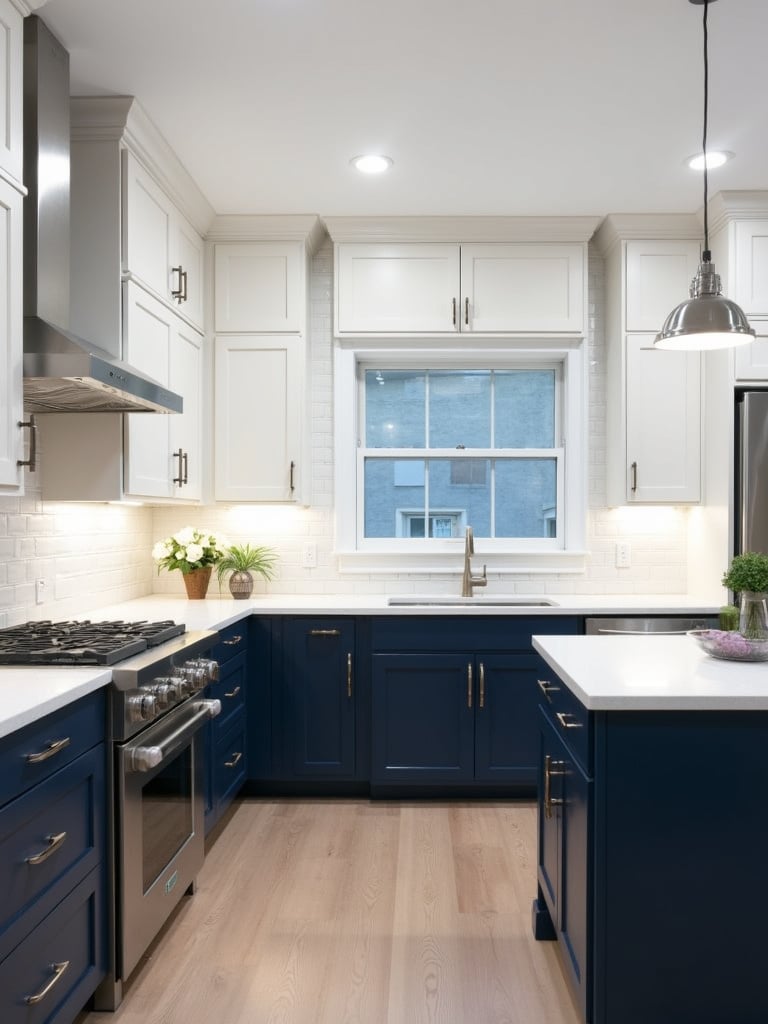
Consider using a contrasting color for your island to make it a true focal point. This technique can help define the kitchen’s work zones while adding architectural interest to your space. The key is choosing colors that complement each other while maintaining the clean lines and sophisticated aesthetic of modern design.
The two-tone trend offers endless possibilities for personalization, from subtle variations in shade to bold color contrasts. Whatever combination you choose, ensure it aligns with your overall color scheme and the natural light in your space.
7. The Innovation of Smart Faucets
In the realm of modern kitchen design, even the humble faucet has received a high-tech makeover. Smart faucets combine sleek aesthetics with cutting-edge functionality, offering touchless operation, precise temperature control, and even voice-activated commands. These innovative fixtures not only improve hygiene but also add a touch of luxury to everyday tasks.

Advanced features like temperature memory and preset volume dispensing make common kitchen tasks more efficient. Imagine preparing your morning coffee with a voice command that dispenses exactly the right amount of water at the perfect temperature, or washing messy hands without touching the faucet and spreading germs.
- Voice-activated operation for hands-free control
- Preset temperature and volume settings
- Water usage monitoring for conservation
- Leak detection and automatic shutoff
- Integration with home automation systems
8. Natural Wood: Bringing Warmth to Modern Spaces
While modern kitchen design often emphasizes sleek materials and clean lines, incorporating natural wood elements adds essential warmth and organic beauty to the space. Wood brings texture and life to contemporary kitchens, preventing them from feeling too sterile or impersonal.

From floating shelves and butcher block islands to accent panels and seating, wood elements can be integrated in countless ways. The key is choosing the right species and finish to complement your overall design scheme while ensuring durability in a high-use environment.
“Wood is like a warm handshake in a modern kitchen – it makes the space feel more welcoming and lived-in.”
When selecting wood elements, consider both aesthetics and practicality. Choose moisture-resistant species for areas near water sources, and ensure proper sealing to protect against daily wear and tear.
9. The Industrial Charm of Concrete Countertops
Modern kitchen design continues to embrace unconventional materials, and concrete countertops stand at the forefront of this trend. These sophisticated surfaces offer a perfect blend of industrial edge and organic appeal, creating a unique foundation for your culinary space. Each concrete countertop tells its own story through subtle variations in color and texture, making your kitchen truly one-of-a-kind.

The versatility of concrete allows for endless customization possibilities. From integral sinks to embedded objects, your countertops can become functional works of art. Color pigments can be added to match any palette, while different finishing techniques create surfaces ranging from glass-smooth to naturally textured.
- Heat-resistant and incredibly durable
- Customizable colors and textures
- Environmentally friendly material options
- Unique character that develops over time
- Seamless integration with modern aesthetics
10. Bold Backsplash Statements
In modern kitchen design, the backsplash has evolved from a purely functional element to a canvas for artistic expression. This vertical space offers the perfect opportunity to introduce bold patterns, interesting textures, or dramatic materials that can define the entire kitchen’s personality.

Consider extending your backsplash from countertop to ceiling behind key areas like the range or sink. This dramatic approach creates a powerful focal point while protecting your walls from cooking splatters and water damage. Large-format tiles, geometric patterns, or continuous slabs of natural stone can create stunning visual impact while maintaining the clean lines essential to modern design.
“Your backsplash is like the signature on your kitchen’s canvas – it should make a statement while complementing the overall composition.”
11. The Power of Neutral Palettes
While modern kitchen design often celebrates bold statements, there’s undeniable power in a well-executed neutral palette. Whites, greys, beiges, and blacks create a sophisticated canvas that stands the test of time while offering endless possibilities for personalization through accessories and accent pieces.

The key to a successful neutral kitchen lies in layering different tones and textures. Mix matte and glossy finishes, incorporate various materials, and play with subtle variations in color to create depth and visual interest. This approach allows architectural elements and quality materials to shine while maintaining a calm, cohesive atmosphere.
Consider how natural light affects your chosen neutrals throughout the day, and don’t forget to include elements that add warmth and prevent the space from feeling sterile. Natural materials, metallic accents, and varied textures can all contribute to a rich, inviting environment.
12. Strategic Pops of Color
Even the most sophisticated modern kitchen design benefits from thoughtfully placed color accents. These vibrant touches can energize your space, define functional areas, and express your personality without overwhelming the clean lines and careful planning of your kitchen’s core design.

The beauty of using color through accessories lies in its flexibility. Seasonal changes are as simple as swapping out dish towels or updating your fruit bowl display. Consider these opportunities for introducing color:
- Statement small appliances in bold hues
- Colorful bar stools or dining chairs
- Vibrant art pieces or photography
- Fresh herbs and produce displays
- Coordinated cookware and utensils
Remember that color can affect mood and energy levels in your kitchen. Choose shades that align with how you want to feel in the space, whether that’s energized and creative or calm and focused.
13. The Social Kitchen: Open Concept Design
The heart of modern kitchen design lies in creating spaces that foster connection and community. Open concept kitchens break down barriers between cooking, dining, and living areas, creating fluid spaces that accommodate both culinary tasks and social interaction.

Success in open concept design requires thoughtful zone planning. Use islands, lighting, and subtle flooring changes to delineate spaces while maintaining visual flow. Consider sight lines and traffic patterns to ensure your kitchen functions efficiently while remaining connected to adjacent areas.
- Define zones through furniture placement
- Use consistent flooring for visual continuity
- Create subtle transitions between spaces
- Plan for adequate ventilation
- Consider acoustic management
14. Casual Elegance: The Kitchen Bar
Modern kitchen design increasingly incorporates dedicated bar areas, creating casual spots for morning coffee, quick meals, or evening entertaining. These spaces can range from a simple extended countertop to elaborate setups with wine storage and specialized appliances.

The key to a successful kitchen bar lies in its positioning and proportions. Ensure adequate legroom and comfortable seating heights, and consider how the bar integrates with your kitchen’s workflow. Adding task lighting and convenient power outlets can transform your bar into a functional workspace for remote work or homework sessions.
When designing your kitchen bar, think about how you’ll use the space throughout the day. Will it serve as a breakfast station, a casual dining area, or an evening entertainment spot? Plan your design and amenities accordingly.
15. Smart Storage Solutions
In modern kitchen design, efficient storage solutions are essential for maintaining clean lines and clutter-free surfaces. Today’s storage options go far beyond basic cabinets, incorporating clever mechanisms and thoughtful organization systems that maximize every inch of space.

Consider these innovative storage solutions:
- Pull-out pantry shelves for easy access
- Vertical dividers for baking sheets and cutting boards
- Corner cabinet carousel systems
- Drawer organizers with adjustable compartments
- Hidden appliance garages
- Built-in recycling and composting centers
The key to successful storage lies in planning around your specific needs and cooking habits. Think about the items you use most frequently and ensure they’re easily accessible while keeping occasional-use items in less prime real estate.
16. Embracing Natural Light
Natural light is a crucial element in modern kitchen design, transforming the space throughout the day and connecting interior spaces with the outside world. Floor-to-ceiling windows, skylights, and strategic window placement can dramatically impact how your kitchen feels and functions.

When planning window placement, consider how natural light will interact with your work surfaces throughout the day. Position prep areas to take advantage of natural light while avoiding harsh glare on screens and shiny surfaces. Don’t forget about task lighting for cloudy days and evening hours.
“Natural light is the most luxurious design element – it’s free, ever-changing, and brings life to every surface it touches.”
17. Indoor-Outdoor Connection
Modern kitchen design increasingly blurs the boundaries between interior and exterior spaces. Sliding glass doors create seamless transitions to outdoor areas, effectively expanding your living space and creating a natural flow for entertaining. This connection to the outdoors brings fresh air, natural light, and a sense of spaciousness that transforms how you experience your kitchen.

Consider creating an outdoor kitchen or dining area that complements your interior space. Use consistent flooring materials and design elements to strengthen the visual connection between indoor and outdoor zones. This approach works particularly well in temperate climates where you can enjoy open-air living throughout much of the year.
- Choose weather-resistant materials for transition areas
- Plan for adequate ventilation when doors are open
- Consider retractable screens for bug protection
- Install proper drainage for outdoor areas
- Use consistent design elements inside and out
18. Sustainable Design Choices
As environmental consciousness grows, modern kitchen design increasingly emphasizes sustainability without sacrificing style. From energy-efficient appliances to eco-friendly materials, today’s kitchens can be both beautiful and environmentally responsible. This approach not only reduces your carbon footprint but often results in lower operating costs and a healthier living environment.

Consider these sustainable options for your kitchen:
- Bamboo or reclaimed wood cabinetry
- Recycled glass countertops
- Low-VOC finishes and adhesives
- Energy Star certified appliances
- Water-efficient faucets and fixtures
- LED lighting systems
- Locally sourced materials
Remember that sustainable choices often bring unique character to your space through natural variations in materials and thoughtful craftsmanship. These elements can become distinctive design features that tell a story while protecting our planet.
“Sustainable design isn’t just about being eco-friendly – it’s about creating spaces that are healthy for both people and the planet.”
19. Textural Intrigue
While modern kitchen design often emphasizes clean lines and smooth surfaces, incorporating varied textures adds depth and visual interest to your space. From rough-hewn stone to smooth glass, textural contrasts create a rich sensory experience that elevates your kitchen beyond the purely functional.

Strategic placement of textured elements can guide the eye and create focal points throughout your kitchen. Consider these opportunities for textural exploration:
- Textured tile backsplashes
- Rough-cut stone accent walls
- Woven pendant light fixtures
- Tactile cabinet finishes
- Natural fiber rugs
- Hammered metal hardware
- Sculptural plant arrangements
The key is balancing different textures while maintaining the clean, sophisticated aesthetic that defines modern design. Too many competing textures can create visual chaos, while too few can leave your kitchen feeling flat and uninspiring.
20. Geometric Expression
In modern kitchen design, geometric patterns offer a powerful way to add visual interest while maintaining clean lines and structured elegance. Whether through flooring, backsplashes, or decorative elements, geometric patterns can create dynamic spaces that feel both contemporary and timeless.

The impact of geometric patterns depends largely on scale and application. Large-format patterns can make bold statements and define spaces, while smaller, more subtle patterns add texture and depth without overwhelming the eye. Consider these applications:
- Hexagonal floor tiles
- Diamond-patterned backsplashes
- Chevron wood grain cabinets
- Triangular open shelving arrangements
- Circular pendant light groupings
When incorporating geometric patterns, maintain balance by keeping some elements simple and understated. Let your chosen pattern be the star while supporting elements play complementary roles.
Bringing It All Together
Modern kitchen design is about creating spaces that balance beauty with functionality, innovation with comfort, and personal style with timeless appeal. Whether you’re planning a complete renovation or looking to update your existing kitchen, these twenty ideas offer a framework for creating a space that works for your lifestyle while pushing the boundaries of contemporary design.
Remember that successful modern kitchens aren’t about following trends blindly – they’re about thoughtfully combining elements that enhance your daily life while creating a visually cohesive and inviting environment. Consider how you use your kitchen, what matters most to you, and which combinations of these design elements will best serve your needs.
As you plan your modern kitchen, keep these key principles in mind:
- Prioritize functionality without sacrificing style
- Create clear zones for different activities
- Incorporate technology thoughtfully
- Choose materials that stand the test of time
- Consider sustainability and environmental impact
- Balance clean lines with warmth and personality
- Plan for adequate storage and organization
- Maximize natural light and connection to outdoor spaces
The best modern kitchens tell a story – your story. They reflect not just contemporary design trends but your unique approach to cooking, entertaining, and living. By thoughtfully incorporating these design elements, you can create a kitchen that’s not just a showcase of modern style but a true reflection of how you live and what you value.
Whether you’re drawn to the minimalist appeal of handleless cabinets, the drama of waterfall countertops, or the practical beauty of sustainable materials, remember that modern kitchen design is ultimately about creating spaces that inspire and support the way we live today. Your perfect kitchen awaits – it’s time to bring your vision to life.
